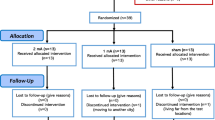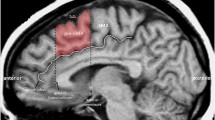Abstract
A non-negligible part of patients with obsessive–compulsive disorder (OCD) experiences inadequate response to pharmacological and cognitive therapies. Therefore, new approaches are required to overcome this problem. The present pilot study estimates the capacity of theta burst stimulation (TBS) in reducing OCD symptoms, also focusing on the neurophysiological basis of TBS aftereffects. Ten patients with OCD who were unsatisfactorily responsive to the pharmacological and neuropsychological treatment, participated to the present randomized crossover pilot study, in which they were subjected to a real or sham intermittent TBS (iTBS) paradigm over the left dorsolateral prefrontal cortex (L-DLPFC) as add-on treatment. They were randomly assigned to a real or sham iTBS in a 1:1 allocation ratio. Patients received the TBS treatment every morning, 5 days a week for 1 month, and were clinically and electrophysiologically evaluated (EEG phase synchronization and coherence) before, immediately after (T0), and one (T1), three (T3) and six (T6) months after the end of the TBS treatment. Then, each patient was subjected to the alternative treatment (that was not practiced before), and followed up to 6 months. We found that all the patients improved in OCD symptomatology up to T1, while four among them improved up to T3. These patients were those showing a more extensive reshape of frontal areas phase synchronization and frontoparietal coherence compared to the other participants. Our pilot study suggests that iTBS over L-DLPFC may represent a feasible approach to improve OCD symptoms. The efficacy of iTBS seems to depend on the extent of frontal and frontoparietal connectivity modulation.



Similar content being viewed by others
References
Abramovitch A, Cooperman A (2015) The cognitive neuropsychology of obsessive-compulsive disorder: a critical review. J Obsess Compuls Relat Disord 5:24–36
Alexander G (1986) Parallel organization of functionally segregated circuits linking basal ganglia and cortex. Annu Rev Neurosci 9(1):357–381
Alvarez JA, Emory E (2006) Executive function and the frontal lobes: a meta-analytic review. Neuropsychol Rev 16(1):17–42
Bandelow B, Zohar J, Hollander E, Kasper S, Möller H, WFSBP Task Force On Treatment Guide (2008) World federation of societies of biological psychiatry (WFSBP) guidelines for the pharmacological treatment of anxiety, obsessive-compulsive and post-traumatic stress disorders—first revision. World J Biol Psychiatry 9(4):248–312
Bation R, Poulet E, Haesebaert F, Saoud M, Brunelin J (2016) Transcranial direct current stimulation in treatment-resistant obsessive-compulsive disorder: an open-label pilot study. Prog Neuropsychopharmacol Biol Psychiatry 65:153–157
Chung SW, Sullivan CM, Rogasch NC, Hoy KE, Bailey NW, Cash RFH, Fitzgerald PB (2019) The effects of individualised intermittent theta burst stimulation in the prefrontal cortex: a TMS-EEG study. Hum Brain Mapp 40(2):608–627
Di Lazzaro V, Pilato F, Dileone M, Profice P, Oliviero A, Mazzone P, Rothwell JC (2008) The physiological basis of the effects of intermittent theta burst stimulation of the human motor cortex. J Physiol 586(16):3871–3879
D’Urso G, Brunoni AR, Anastasia A, Micillo M, de Bartolomeis A, Mantovani A (2016) Polarity-dependent effects of transcranial direct current stimulation in obsessive-compulsive disorder. Neurocase 22:60–64
Fitzgerald KD, Stern ER, Angstadt M, Nicholson-Muth KC, Maynor MR, Welsh RC et al (2010) Altered function and connectivity of the medial frontal cortex in pediatric obsessive–compulsive disorder. Biol Psychiatry 68:1039–1047
Goodman WK, Price LH, Rasmussen SA, Mazure C, Fleischmann RL, Hill CL et al (1989) The yale-brown obsessive-compulsive scale. I. Development, use, and reliability. Arch Gen Psychiatry 46:1006–1011
Greenberg BD, George MS, Martin JD, Benjamin J, Schlaepfer TE, Altemus M, Wassermann EM, Post RM, Murphy DL (1997) Effect of prefrontal repetitive transcranial magnetic stimulation in obsessive-compulsive disorder: a preliminary study. Am J Psychiatry 154(6):867–869
Haber SN (2003) The primate basal ganglia: Parallel and integrative networks. J Chem Neuroanat 26(4):317–330
Harrison BJ, Soriano-Mas C, Pujol J, Ortiz H, López-Solà M, Hernández-Ribas R et al (2009) Altered corticostriatal functional connectivity in obsessive-compulsive disorder. Arch Gen Psychiatry 66:1189–1200
Horwath E, Weissman MM (2000) The epidemiology and cross-national presentation of obsessive-compulsive disorder Psychiatr. Clin North Am 23:493–507
Huang YZ, Edwards MJ, Rounis E, Bhatia KP, Rothwell JC (2005) Theta burst stimulation of the human motor cortex. Neuron 45(2):201–206
Huang YZ, Rothwell JC, Edwards MJ, Chen RS (2008) Effect of physiological activity on an NMDA-dependent form of cortical plasticity in human. Cereb Cortex 18(3):563–570
Jahangard L, Haghighi M, Shyayganfard M, Ahmadpanah M, Bahmani DS, Bajoghli H, Brand S (2016) Repetitive transcranial magnetic stimulation improved symptoms of obsessive-compulsive disorder, but also cognitive performance: results from a randomized clinical trial with a cross-over design and sham condition. Neuropsychobiology 73(4):224–232
Klimke A, Nitsche MA, Maurer K, Voss U (2016) Case report: successful treatment of therapy-resistant OCD with application of transcranial alternating current stimulation (tACS). Brain Stimul 9:463–465
Lapidus KA, Stern ER, Berlin HA, Goodman WK (2014) Neuromodulation for obsessive-compulsive disorder. Neurotherapeutics 11:485–495
Lara GA, Alekseichuk I, Turi Z, Lehr A, Antal A, Paulus W (2018) Perturbation of theta-gamma coupling at the temporal lobe hinders verbal declarative memory. Brain Stimul 11:509–517
Lisanby SH, Gutman D, Luber B, Schroeder C, Sackeim HA (2001) Sham TMS: intracerebral measurement of the induced electrical field and the induction of motor-evoked potentials. Biol Psychiatry 49(5):460–463
Lisman JE, Jensen O (2013) The theta-gamma neural code. Neuron 77:1002–1016
Lusicic A, Schruers KR, Pallanti S, Castle DJ (2018) Transcranial magnetic stimulation in the treatment of obsessive-compulsive disorder: current perspectives. Neuropsychiatr Dis Treat 14:1721–1736
Ma X, Huang Y, Liao L, Jin Y (2014) A randomized double-blinded sham-controlled trial of electroencephalogram-guided transcranial magneticStimulationfor obsessive–compulsive disorder. Chin Med J 127:601–606
Macdonald AW, Cohen JD, Stenger VA, Carter CS (2000) Dissociating the role of the dorsolateral prefrontal and anterior cingulate cortex in cognitive control. Science 288(5472):1835–1838
Mantovani A, Rossi S, Bassi BD, Simpson HB, Fallon BA, Lisanby SH (2013) Modulation of motor cortex excitability in obsessive-compulsive disorder: an exploratory study on the relations of neurophysiology measures with clinical outcome. Psychiatry Res 210(3):1026–1032
Mataix-Cols D, Heuvel OA (2006) Common and distinct neural correlates of obsessive-compulsive and related disorders. Psychiatr Clin North Am 29(2):391–410
Menzies L, Chamberlain SR, Laird AR, Thelen SM, Sahakian BJ, Bullmore ET (2008) Integrating evidence from neuroimaging and neuropsychological studies of obsessive-compulsive disorder: the orbitofronto-striatal model revisited. Neurosci Biobehav Rev 32(3):525–549
Milad MR, Rauch SL (2012) Obsessive-compulsive disorder: beyond segregated cortico-striatal pathways. Trends Cogn Sci 16(1):43–51
Miyaguchi S, Otsuru N, Kojima S, Saito K, Inukai Y, Masaki M, Onishi H (2018) Transcranial alternating current stimulation with gamma oscillations over the primary motor cortex and cerebellar hemisphere improved visuomotor performance. Front Behav Neurosci 12:132
Mondino M, Haesebaert F, Poulet E, Suaud-Chagny MF, Brunelin J (2015) Efficacy of cathodal transcranial direct current stimulation over the left orbitofrontal cortex in a patient with treatment-resistant obsessive-compulsive disorder. J ECT 31:271–272
Nakao T, Okada K, Kanba S (2014) Neurobiological model of obsessive-compulsive disorder: evidence from recent neuropsychological and neuroimaging findings. Psychiatry Clin Neurosci 68:587–605
Narayanaswamy JC, Jose D, Chhabra H, Agarwal SM, Shrinivasa B, Hegde A, Bose A, Kalmady SV, Venkatasubramanian G, Reddy YCJ (2015) Successful application of add-on transcranial direct current stimulation (tDCS) for treatment of SSRI resistant OCD. Brain Stimul 8:655–657
Nichols TE, Holmes AP (2002) Nonparametric permutation tests for functional neuroimaging: a primer with examples. Hum Brain Mapp 15:1–25
Nordmann G, Azorina V, Langguth B, Schecklmann M (2015) A systematic review of non-motor rTMS induced motor cortex plasticity. Front Hum Neurosci 9:416
Olbrich S, Olbrich H, Adamaszek M, Jahn I, Hegerl U, Stengler K (2013) Altered EEG lagged coherence during rest in obsessive–compulsive disorder. Clin Neurophysiol 124:2421–2430
Pallanti S, Quercioli L (2006) Treatment-refractory obsessive-compulsive disorder: methodological issues, operational definitions and therapeutic lines. Prog Neuropsychopharmacol Biol Psychiatry 30:400–412
Pascual-Marqui RD (2007) Instantaneous and lagged measurements of linear and nonlinear dependence between groups of multivariate time series: frequency decomposition. ArXiv 0711.1455
Pascual-Marqui RD, Esslen M, Kochi K, Lehmann D (2002) Functional imaging with low-resolution brain electromagnetic tomography (LORETA): a review. Methods Find Exp Clin Pharmacol 24(Suppl. C):91–95
Pena-Garijo J, Ruipérez-Rodríguez MA, Barros-Loscertales A (2010) The neurobiology of obsessive-compulsive disorder: new findings from functional magnetic resonance imaging. Rev Neurol 50(8):477–485
Rachid F (2017) Safety and efficacy of theta-burst stimulation in the treatment of psychiatric disorders: a review of the literature. J Nerv Ment Dis 205(11):823–839
Robertson E, Tormos J, Maeda F, Pascual-Leone A (2001) The role of the dorsolateral prefrontal cortex during sequence learning is specific for spatial information. Cereb Cortex 11(7):628–635
Rossi S, Bartalini S, Ulivelli M, Mantovani A, Muro AD, Goracci A, Passero S (2005) Hypofunctioning of sensory gating mechanisms in patients with obsessive-compulsive disorder. Biol Psychiat 57(1):16–20
Russo M, Naro A, Mastroeni C, Morgante F, Terranova C, Muscatello MR, Zoccali R, Calabrò RS, Quartarone A (2014) Obsessive-compulsive disorder: a “sensory-motor” problem? Int J Psychophysiol 92(2):74–78
Sachdev PS, Loo CK, Mitchell PB, McFarquhar TF, Malhi GS (2007) Repetitive transcranial magnetic stimulation for the treatment of obsessive compulsive disorder: a double-blind controlled investigation. Psychol Med 37(11):1645–1649
Schruers K, Koning K, Luermans J, Haack MJ, Griez E (2005) Obsessive–compulsive disorder: a critical review of therapeutic perspectives. Acta Psychiatr Scand 111(4):261–271
Storch EA, De Nadai AS, Conceição Do Rosário M, Shavitt RG, Torres AR, Ferrão YA, Fontenelle LF (2015) Defining clinical severity in adults with obsessive-compulsive disorder. Compr Psychiatry 63:30–35
Suppa A, Huang Y, Funke K, Ridding M, Cheeran B, Lazzaro VD, Rothwell J (2016) Ten years of theta burst stimulation in humans: established knowledge, unknowns and prospects. Brain Stimul 9(3):323–335
Talelli P, Greenwood RJ, Rothwell JC (2007) Exploring theta burst stimulation as an intervention to improve motor recovery in chronic stroke. Clin Neurophysiol 118(2):333–342
Trevizol AP, Shiozawa P, Cook IA, Sato IA, Kaku CB, Guimaraes FB, Sachdev P, Sarkhel S, Cordeiro Q (2016) Transcranial magnetic stimulation for obsessive-compulsive disorder: an updated systematic review and meta-analysis. J ECT 32(4):262–266
Van den Heuvel OA, van Wingen G, Soriano-Mas C, Alonso P, Chamberlain SR, Nakannae T, Veltman DJ (2016) Brain circuitry of compulsivity. Eur Neuropsychopharmacol 26(5):810–827
Wassermann EM, Lisanby SH (2001) Therapeutic application of repetitive transcranial magnetic stimulation: a review. Clin Neurophysiol 112(8):1367–1377
Wu C, Tsai C, Lu M, Chen C, Shen W, Su K (2010) Theta-burst repetitive transcranial magnetic stimulation for treatment-resistant obsessive-compulsive disorder with concomitant depression. J Clin Psychiatry 71(04):504–506
Zhou D, Wang W, Wang G, Li D, Kuang L (2017) An updated meta-analysis: short-term therapeutic effects of repeated transcranial magnetic stimulation in treating obsessive-compulsive disorder. J Affect Disord 215:187–196
Funding
No funding to be reported.
Author information
Authors and Affiliations
Corresponding author
Ethics declarations
Conflict of interest
The authors declare that they have no competing interests.
Ethical approval
All procedures performed in studies involving human participants were in accordance with the ethical standards of the institutional and/or national research committee and with the 1964 Helsinki Declaration and its later amendments or comparable ethical standards.
Informed consent
Informed consent was obtained from all individual participants included in the study.
Data availability
The data sets used and/or analyzed during the current study are available from the corresponding author on reasonable request.
Additional information
Publisher's Note
Springer Nature remains neutral with regard to jurisdictional claims in published maps and institutional affiliations.
Rights and permissions
About this article
Cite this article
Naro, A., Billeri, L., Cannavò, A. et al. Theta burst stimulation for the treatment of obsessive–compulsive disorder: a pilot study. J Neural Transm 126, 1667–1677 (2019). https://doi.org/10.1007/s00702-019-02098-6
Received:
Accepted:
Published:
Issue Date:
DOI: https://doi.org/10.1007/s00702-019-02098-6




